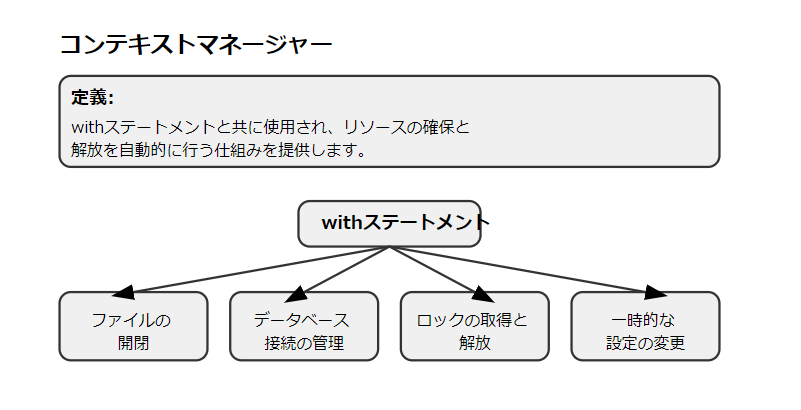はじめに
こんにちは!今回は、Pythonのコンテキストマネージャーについて深掘りします。特に、withステートメントの使用方法とカスタムコンテキストマネージャーの実装方法に焦点を当てて解説します。コンテキストマネージャーを理解し、適切に使用することで、より安全で効率的なコードを書くことができます。
1. コンテキストマネージャーとは
コンテキストマネージャーは、withステートメントと共に使用され、リソースの確保と解放を自動的に行う仕組みを提供します。主な用途は以下の通りです:
- ファイルの開閉
- データベース接続の管理
- ロックの取得と解放
- 一時的な設定の変更
2. withステートメントの基本
2.1 ファイル操作の例
with open('example.txt', 'w') as f:
f.write('Hello, World!')
このコードでは、ファイルは自動的に閉じられます。これにより、リソースリークを防ぎ、例外が発生した場合でも適切にファイルが閉じられることが保証されます。
2.2 複数のコンテキストマネージャーの使用
with open('input.txt', 'r') as input_file, open('output.txt', 'w') as output_file:
data = input_file.read()
output_file.write(data.upper())
3. カスタムコンテキストマネージャーの実装
3.1 クラスベースの実装
カスタムコンテキストマネージャーを作成するには、__enter__と__exit__メソッドを実装します。
class CustomContextManager:
def __init__(self, name):
self.name = name
def __enter__(self):
print(f"Entering the context of {self.name}")
return self
def __exit__(self, exc_type, exc_value, traceback):
print(f"Exiting the context of {self.name}")
if exc_type is not None:
print(f"An exception occurred: {exc_type}, {exc_value}")
return False # 例外を再発生させる
# 使用例
with CustomContextManager("MyContext") as cm:
print("Inside the context")
# raise ValueError("Something went wrong")
3.2 関数ベースの実装(contextlib.contextmanager)
contextlib.contextmanagerデコレータを使用すると、ジェネレータ関数を使ってより簡潔にコンテキストマネージャーを実装できます。
from contextlib import contextmanager
@contextmanager
def custom_context_manager(name):
print(f"Entering the context of {name}")
try:
yield name
except Exception as e:
print(f"An exception occurred: {type(e)}, {e}")
raise
finally:
print(f"Exiting the context of {name}")
# 使用例
with custom_context_manager("MyContext") as name:
print(f"Inside the context of {name}")
# raise ValueError("Something went wrong")
4. 実践的な使用例
4.1 データベース接続の管理
import sqlite3
from contextlib import contextmanager
@contextmanager
def database_connection(db_name):
conn = sqlite3.connect(db_name)
try:
yield conn
finally:
conn.close()
# 使用例
with database_connection('example.db') as conn:
cursor = conn.cursor()
cursor.execute("SELECT * FROM users")
results = cursor.fetchall()
print(results)
4.2 一時的な設定変更
import os
from contextlib import contextmanager
@contextmanager
def set_temporary_env_var(key, value):
old_value = os.environ.get(key)
os.environ[key] = value
try:
yield
finally:
if old_value is None:
del os.environ[key]
else:
os.environ[key] = old_value
# 使用例
print(os.environ.get('MY_VAR')) # None
with set_temporary_env_var('MY_VAR', 'temp_value'):
print(os.environ.get('MY_VAR')) # temp_value
print(os.environ.get('MY_VAR')) # None
5. コンテキストマネージャーの高度な使用法
5.1 非同期コンテキストマネージャー
Python 3.7以降では、非同期コンテキストマネージャーを使用できます。
import asyncio
class AsyncContextManager:
async def __aenter__(self):
print("Entering the async context")
await asyncio.sleep(1)
return self
async def __aexit__(self, exc_type, exc_value, traceback):
print("Exiting the async context")
await asyncio.sleep(1)
async def main():
async with AsyncContextManager() as acm:
print("Inside the async context")
asyncio.run(main())
5.2 コンテキストマネージャーのネスト
コンテキストマネージャーは、必要に応じてネストすることができます。
from contextlib import contextmanager
@contextmanager
def outer_context():
print("Entering outer context")
try:
yield "outer"
finally:
print("Exiting outer context")
@contextmanager
def inner_context():
print("Entering inner context")
try:
yield "inner"
finally:
print("Exiting inner context")
with outer_context() as outer:
print(f"In {outer} context")
with inner_context() as inner:
print(f"In {inner} context")
6. コンテキストマネージャーのベストプラクティスと注意点
-
リソースの適切な管理: コンテキストマネージャーは、リソースの確実な解放を保証するために使用しましょう。
-
例外処理:
__exit__メソッドで例外を適切に処理し、必要に応じて再発生させましょう。 -
シンプルさを保つ: コンテキストマネージャーは単一の責任を持つようにし、複雑な論理は避けましょう。
-
再利用性: 汎用的なコンテキストマネージャーを作成し、コードの再利用性を高めましょう。
-
デバッグのしやすさ: コンテキストの開始と終了時にログを出力するなど、デバッグをしやすくする工夫をしましょう。
-
パフォーマンスの考慮: 頻繁に使用されるコンテキストマネージャーの場合、オーバーヘッドに注意しましょう。
まとめ
コンテキストマネージャーは、Pythonにおけるリソース管理と例外処理の強力なツールです。withステートメントを使用することで、コードの可読性が向上し、リソースリークのリスクを減らすことができます。
カスタムコンテキストマネージャーを実装することで、特定のユースケースに合わせたリソース管理や一時的な状態変更を行うことができます。クラスベースの実装とcontextlib.contextmanagerデコレータを使用した関数ベースの実装の両方を理解し、状況に応じて適切な方法を選択することが重要です。
コンテキストマネージャーを適切に使用することで、より堅牢で保守性の高いPythonコードを書くことができます。ぜひ、日々のコーディングでコンテキストマネージャーを積極的に活用してみてください。
以上、コンテキストマネージャーの深掘りについての記事でした。ご清読ありがとうございました!
参考記事


